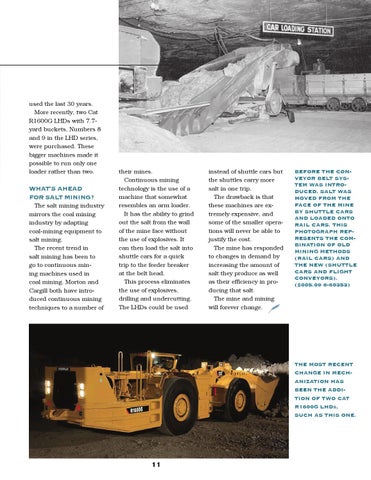used the last 30 years. More recently, two Cat R1600G LHDs with 7.7yard buckets, Numbers 8 and 9 in the LHD series, were purchased. These bigger machines made it possible to run only one loader rather than two.
WHAT’S AHEAD FOR SALT MINING? The salt mining industry mirrors the coal mining industry by adapting coal-mining equipment to salt mining. The recent trend in salt mining has been to go to continuous mining machines used in coal mining. Morton and Cargill both have introduced continuous mining techniques to a number of
their mines. Continuous mining technology is the use of a machine that somewhat resembles an arm loader. It has the ability to grind out the salt from the wall of the mine face without the use of explosives. It can then load the salt into shuttle cars for a quick trip to the feeder breaker at the belt head. This process eliminates the use of explosives, drilling and undercutting. The LHDs could be used
instead of shuttle cars but the shuttles carry more salt in one trip. The drawback is that these machines are extremely expensive, and some of the smaller operations will never be able to justify the cost. The mine has responded to changes in demand by increasing the amount of salt they produce as well as their efficiency in producing that salt. The mine and mining will forever change.
BEFORE THE CONVEYOR BELT SYSTEM WAS INTRODUCED, SALT WAS MOVED FROM THE FACE OF THE MINE BY SHUTTLE CARS AND LOADED ONTO RAIL CARS. THIS PHOTOGRAPH REPRESENTS THE COMBINATION OF OLD MINING METHODS (RAIL CARS) AND THE NEW (SHUTTLE CARS AND FLIGHT CONVEYORS). (2005.09 6-60353)
h
THE MOST RECENT CHANGE IN MECHANIZATION HAS BEEN THE ADDITION OF TWO CAT R1600G LHDS, SUCH AS THIS ONE.
11
